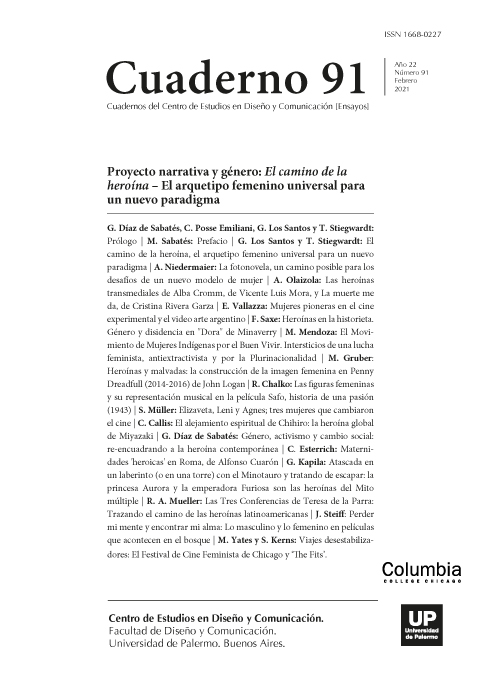El camino de la heroína, el arquetipo femenino universal para un nuevo paradigma.
Abstract
In the narrative territory, the fable has been established from a male conception since the foundational times of culture. Nevertheless, strong female characters (heroines) have existed from Aristófanes (Lysistrata) to the present day; Joan of Arc, the Celtic Queen Boudicca, Juana Azurduy (Argentine historical character); Mérida from “Brave”, Katniss Everdeen in The Hunger Games, Khalessi in Game of Thrones; female Captain Marvel, Wonder Woman; Beatrix Kiddo from Kill Bill, Trinity in Matrix, Rey the scavenger in Star Wars (who incarnates “The Force” and stands up to the Empire). Hundreds of examples exist where we can find a structural, aesthetic and ethical change which refresh narratives and their fables.
Women have advanced noticeably in every field in these past years thanks to the struggle of feminist movements. As a consequence of the permanent quest in search of their social role, and the evident failure of the patriarchal system, cracks in the social structure are appearing. The transformation powered by the Women’s movements traverse the core structure of our society, making itself evident in different aspects of culture, in its more ample definition. The emergence of a new female character -a restricted role model before now- challenges the existing archetypical structures and promises changes towards a new, wider, more inclusive and diverse narrative.
In the present day, empowered women’s participation in all social strata is on the rise. This is true for the social, material world and is also observable in the cultural mirror through diverse artistic productions; narrative in film and television, literature, mass media and digital platforms.
A democratization process of information, aesthetic and argumentative criteria appears to inaugurate -at a slow but steady pace- a new figurative view of the world. One of the more present, recognizable and active forms is the audiovisual account in which new archetypes of heroic characters, with intrinsically feminine attributes conquer the stories, the audience and box office.
If for humanity storytelling has been founding of its own culture, the change in form, manner and point of view, -thus a transformation in the way we narrate- changes the historical conception and cosmovision of the world. The new fable shall not be the like the on before it, neither will it be like its opposite: it shall be a completely different conception, transversal, multidimensional, inclusive and creative.
This projects aims to breach dominant ways of thinking and generate a new map in the narrative territory towards the discovery of new worlds.
References
Lieberman, Al. (2006). La Revolución del Marketing del Entretenimiento (UP) Aristóteles, (siglo IV AC.) Poética
Bordwell, D. (1985). La narración en el cine de ficción. Editorial Paidós. Barcelona, España
Campbell, J. (1959). El héroe de las mil caras, psicoanálisis del mito. Fondo de cultura económica, México (pp. 55, 62, 90, 99, 107)
Campbell J. (1991). El poder del mito, Emecé, Barcelona (pp. 38)
Campbell, J. (1980). Los mitos en el tiempo. Emecé Editores. Buenos Aires, Argentina
Eco, U. (1974). La Estructura Ausente, Editorial Lumen. Barcelona, España
Frazer, G. (1944). La Rama Dorada. Editorial Fondo de Cultura Económica. Santa Fe de Bogotá, Colombia
García Márquez, G. (1995). Como se escribe un cuento. Editorial Voluntad, Santa Fe de Bogotá.
Graves, R. (2007). Los mitos griegos. Alianza Editorial. Buenos Aires, Argentina
Heindel, M (1932). Misterios de las grandes óperas. Editorial. Kier, Buenos Aires, Argentina.
Jung, C.G. (1993). Encuentro con la Sombra (compilación) Editorial Kairós, Buenos Aires, Argentina
Jung, C.G (1976). Psicología y Religión. Editorial Paidós. Barcelona, España
Jung, C.G. (1964). El hombre y sus símbolos. Editorial Paidós, Barcelona, España
Jung, C.G. (1951). AION Contribución a los simbolismos del sí mismo. Paidós, Buenos Aires, Argentina
Maitena (2006). Mujeres Alteradas. Sudamericana Lumen
May, R. (1993). Encuentro con la Sombra, Editorial Kairós, Buenos Aires, Argentina
McKee, R. (1997). Story, el guión. Editorial Alba. Barcelona, España
Niedner, H. (1986). Mitología Nórdica. Editorial Edicomunicación. Barcelona, España
Quino (2001). Toda Mafalda. Ediciones de la Flor
Salas Sommer, D. (1998). Moral para el Siglo XXI, Fundación Instituto Filosófico Hermético, Buenos Aires, Argentina
Segato, R. (2018). Contra-Pedagogías de la crueldad, Prometeo Libros, Buenos Aires, Argentina
Segato, R. (2016). La guerra contra las mujeres, Ed. Traficantes de Sueños
Seger, L (1987). Como convertir un buen guión en un guión excelente. Editorial Rialp, Buenos Aires, Argentina
Velayos, T. (1995). George Lucas el poder de la fuerza. Editorial Royal Books, Barcelona, España
Vogler C. (2005). El viaje del escritor. Madrid: Robin Book.
Los autores/as que publiquen en esta revista ceden los derechos de autor y de publicación a "Cuadernos del Centro de Estudios de Diseño y Comunicación", Aceptando el registro de su trabajo bajo una licencia de atribución de Creative Commons, que permite a terceros utilizar lo publicado siempre que de el crédito pertinente a los autores y a esta revista.


